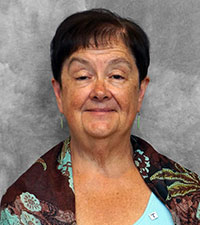 There was never a time in Maureen Hellwig’s life that she was not somehow related to the School Sisters of St. Francis. In grade school, at St. Matthias in Chicago, she took piano lessons from Sister Marcella (Sister Catherine H. Ryan). Because Alvernia wanted musicians to prepare girls to come to Alvernia and play in the orchestra, in sixth grade Maureen began to take cello lessons. Marcella was upbeat by nature and had a good sense of humor; she was someone Maureen could talk to.
There was never a time in Maureen Hellwig’s life that she was not somehow related to the School Sisters of St. Francis. In grade school, at St. Matthias in Chicago, she took piano lessons from Sister Marcella (Sister Catherine H. Ryan). Because Alvernia wanted musicians to prepare girls to come to Alvernia and play in the orchestra, in sixth grade Maureen began to take cello lessons. Marcella was upbeat by nature and had a good sense of humor; she was someone Maureen could talk to.
By eighth grade, Maureen was considering joining the convent. Marcella advised her, “Don’t go to community now. Wait until after high school, and if you’re still sure, go then. Meanwhile, enjoy your high school years at Alvernia.” To this day, Maureen is grateful for this advice.
Maureen went to Alvernia where she met still more sisters. Sister Angelica (Ann Seng), her teacher for sociology, sent the students out to diverse neighborhoods to study the social systems in the city. Maureen remembers going to Friendship House at 42nd and Indiana, a place where black and white people could meet – not an experience most white girls her age had.
In 1962, while Maureen was still in high school, Sisters Ann Seng, Arlene Woelfel, and Cecilia Marie Day joined with other religious and picketed the Catholic Women’s Council to protest their policy of not allowing African Americans to use their swimming pool. This pool was located in the Lewis Tower building of the Loyola University downtown campus. Seeing a photo of her high school teachers in The Chicago Tribune was a profound lesson in social justice.
After high school, Maureen entered the community. As she moved on to the Novitiate, it was Sister Mary Dingman’s first year as novice mistress. In addition to her spiritual leadership, what Maureen delighted in most is that Mary often played pinochle with them on Sundays!
When it came time to go on mission, Maureen wanted to go to Santa Maria Addolorata School in Chicago. This was a School Sisters of St. Francis community that was very active in the neighborhood as Latino immigrants came to live there, next door to earlier generations from Italy and Poland. The principal, Sister Antonelda (Marian Dahlke), was on the board of Erie House, a Presbyterian-sponsored settlement house, just a block from the school. The sisters taught during the day and attended community meetings at night, at Erie House and elsewhere. Sisters Therese Brown, Susan Rosenbach, Mary Beth Minkel, and Regine Barry were part of the faculty. Maureen taught social studies.
Maureen stayed at Santa Maria for two years, and then moved to St. Benedict High School, again to teach social studies. Here she and a fellow teacher, George Rader, created a course in which students would leave school on Tuesdays at 2:00 to go to visit various neighborhoods in the city. They named the course, “Chicago.” The rationale for this course was that students on the north side of the city did not know that Hyde Park was not a suburb. When riding the Illinois Central train to Hyde Park, they still thought it must be a suburb. Then they saw the University of Chicago campus and could recognize its urban setting.
In 1973, Maureen felt that she needed more flexibility in her work than what religious life offered. She always says that she did not leave “community,” that is, the spirit, the people who were the School Sisters of St. Francis. She only left the structure. This transition actually inspired the beginning of Associate Relationship: a desire to be with the community but without the formal vows.
Maureen recalls the initial resistance she found among some sisters toward establishing Associate Relationship, but her provincial, Sister Kate Brenner and Sister Ann Mary Bender, were supportive of what she wanted to do. The community’s leadership prevailed and the General Assembly voted to explore, and eventually approve, Associate Relationship in 1972. Maureen signed her first associate agreement shortly after that.
In recent years, the other community Maureen has found to associate with is the Old St. Patrick Parish community, just west of downtown Chicago. “If you want to find young people who are interested in religion, come to Old St. Pat’s,” Maureen said. It is a community of people who live by the gospel in a truly post-Vatican II church. On Holy Saturday you might encounter as many as 50 people asking to be baptized. From Maureen’s perspective, this might be fruitful ground for finding more people who could become associates.
Looking back, Maureen sees that the School Sisters of St. Francis were far ahead of where the Church was as she was growing up into womanhood. As she has come to see God’s Son, Jesus, and his life of standing up for people in need, as a model for everyone’s life, she is thankful to the sisters for sharpening that image for her.